Abstract
Intraspecific and interspecific communication and recognition depend on olfaction in widely diverse species of animals. Olfaction, an ancient sensory modality, is based on principles of neural organization and function that appear to be remarkably similar throughout the zoosphere. Thus, the "primitives" of olfactory stimuli that determine the input information of olfaction, the kinds of "molecular images" formed at various levels in the olfactory pathway, and the cellular mechanisms that underlie olfactory information processing are comparable in invertebrates and vertebrates alike. A case in point is the male-specific olfactory subsystem in moths, which is specialized to detect and analyze the qualitative, quantitative, and temporal features of the con-specific females' sex-pheromonal chemical signal. This olfactory subsystem can be viewed, and is here presented, as a model in which common principles of organization and function of olfactory systems in general are exaggerated to serve the requirements of a chemical communication system that is crucial for reproductive success.
Full text
PDF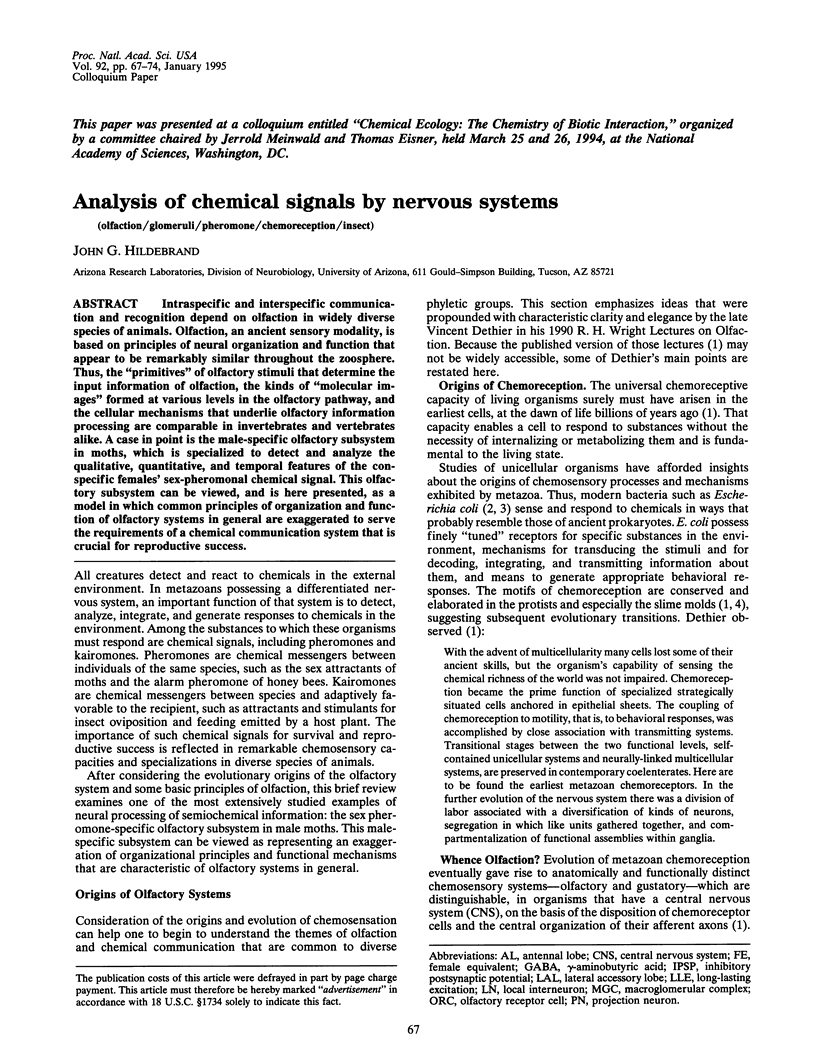
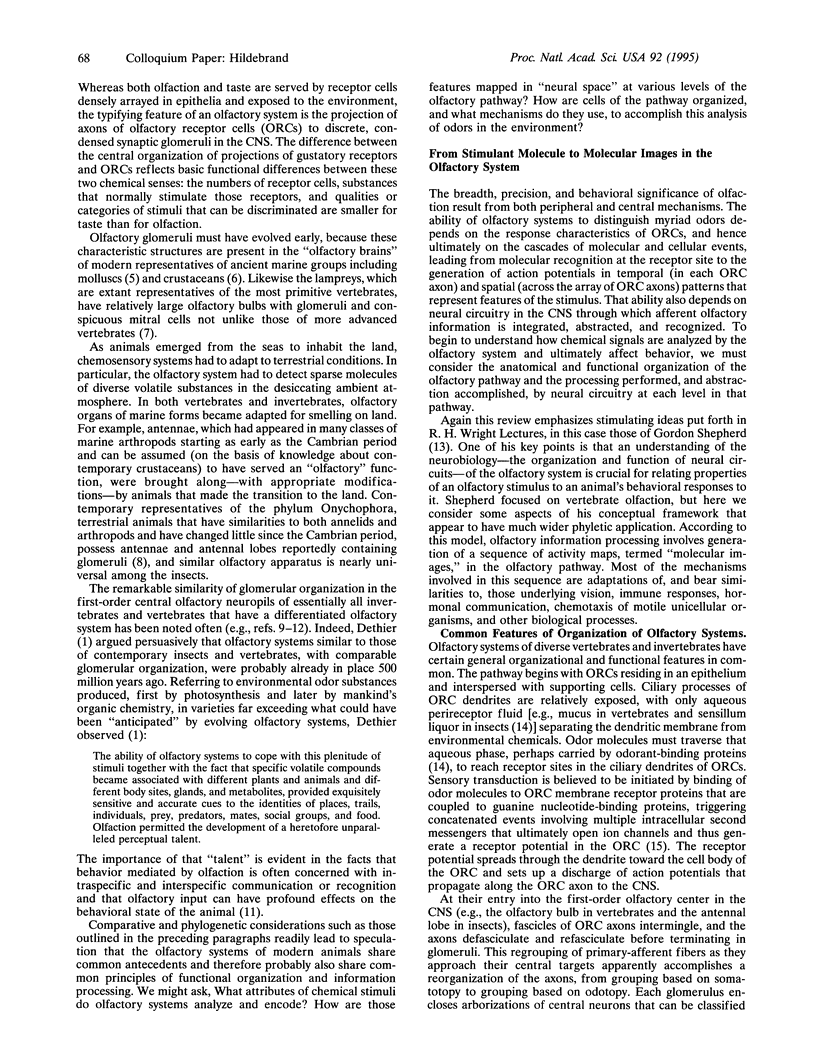
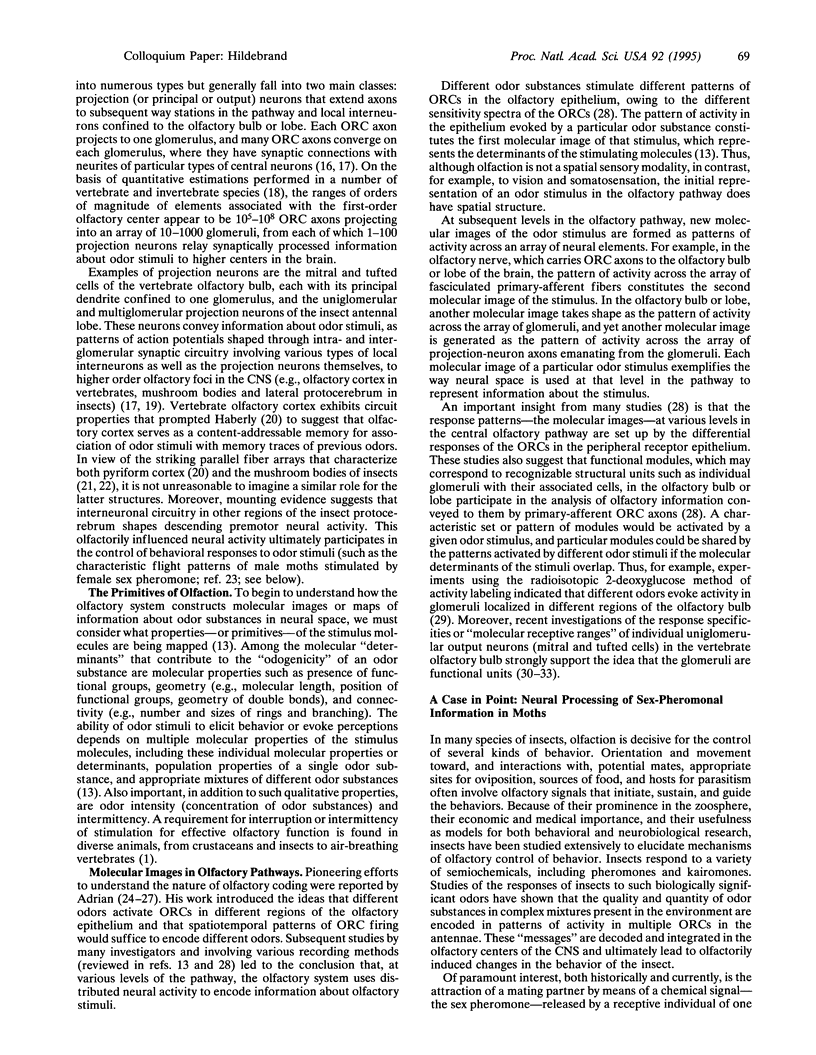
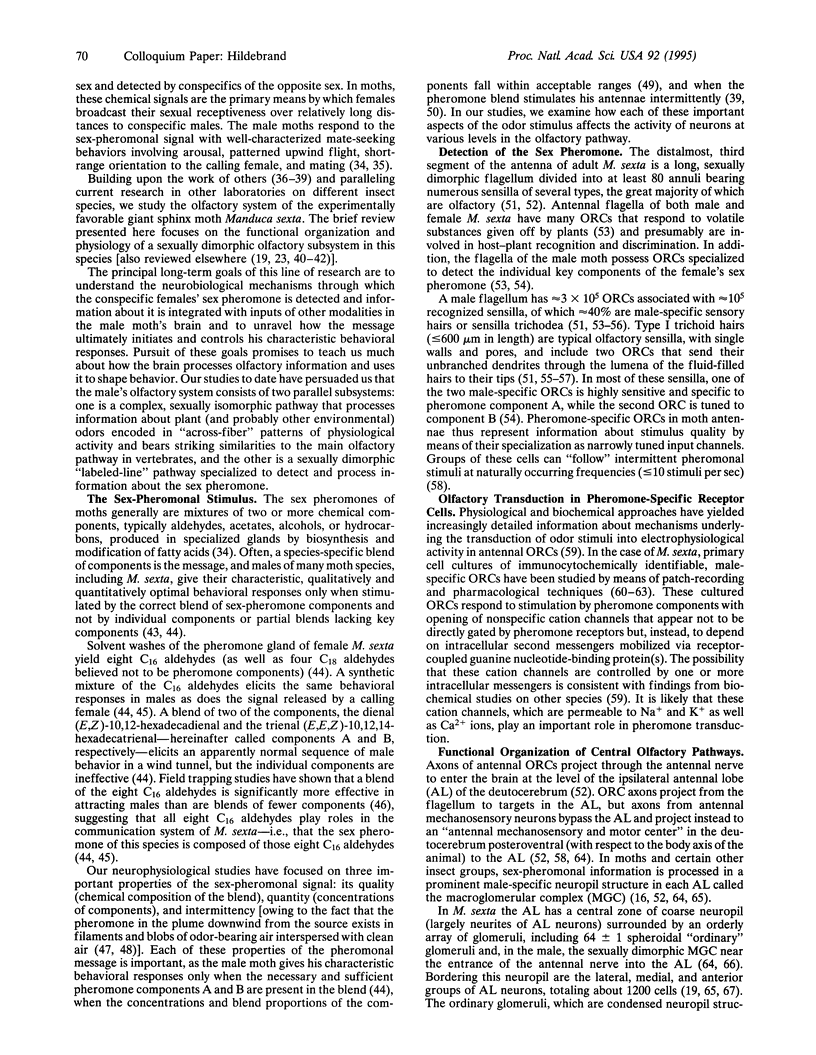
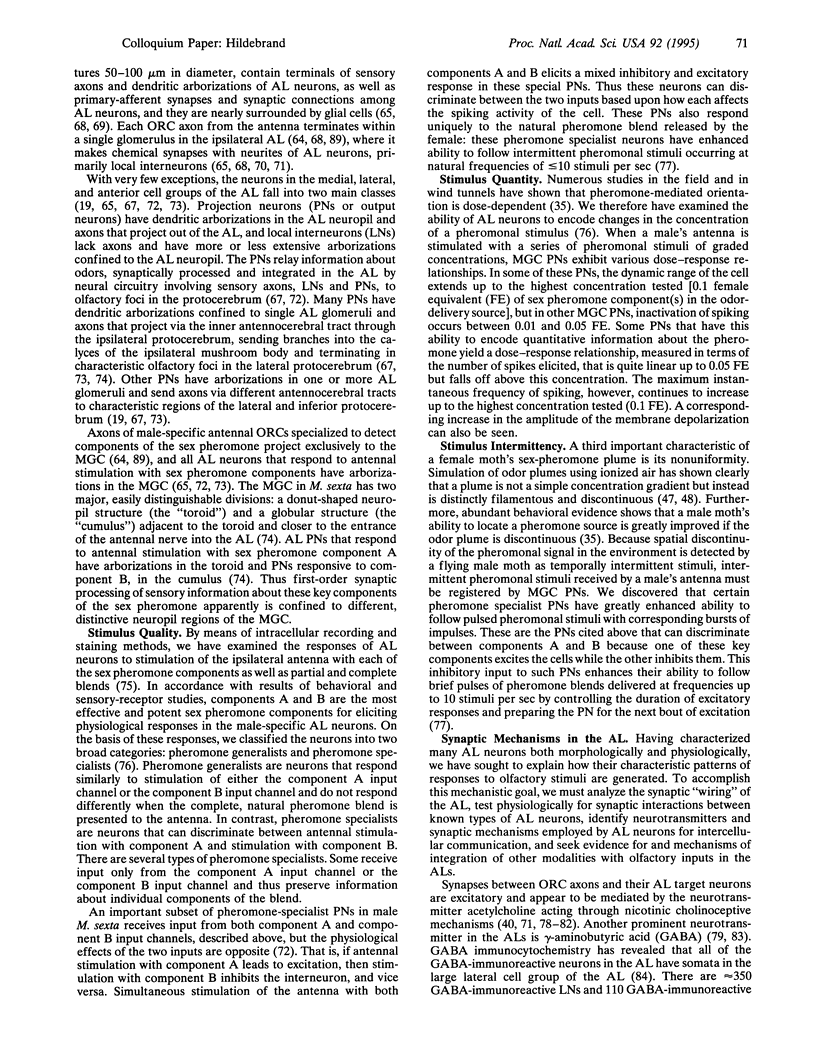
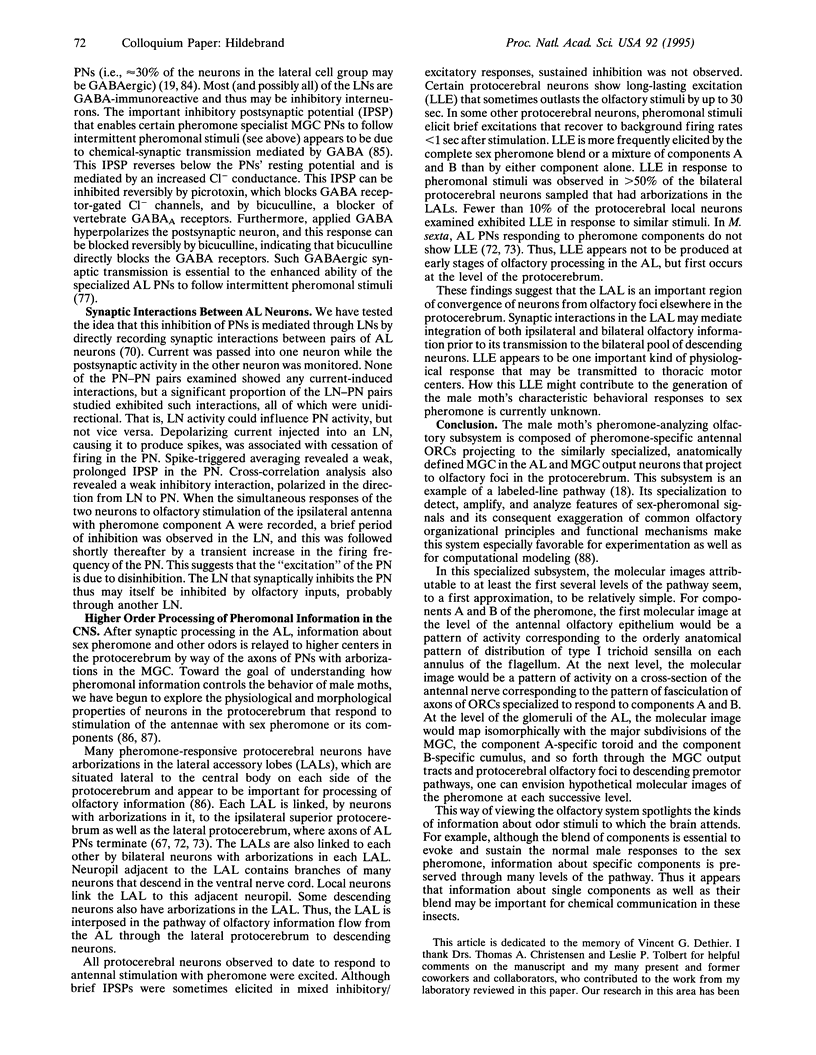
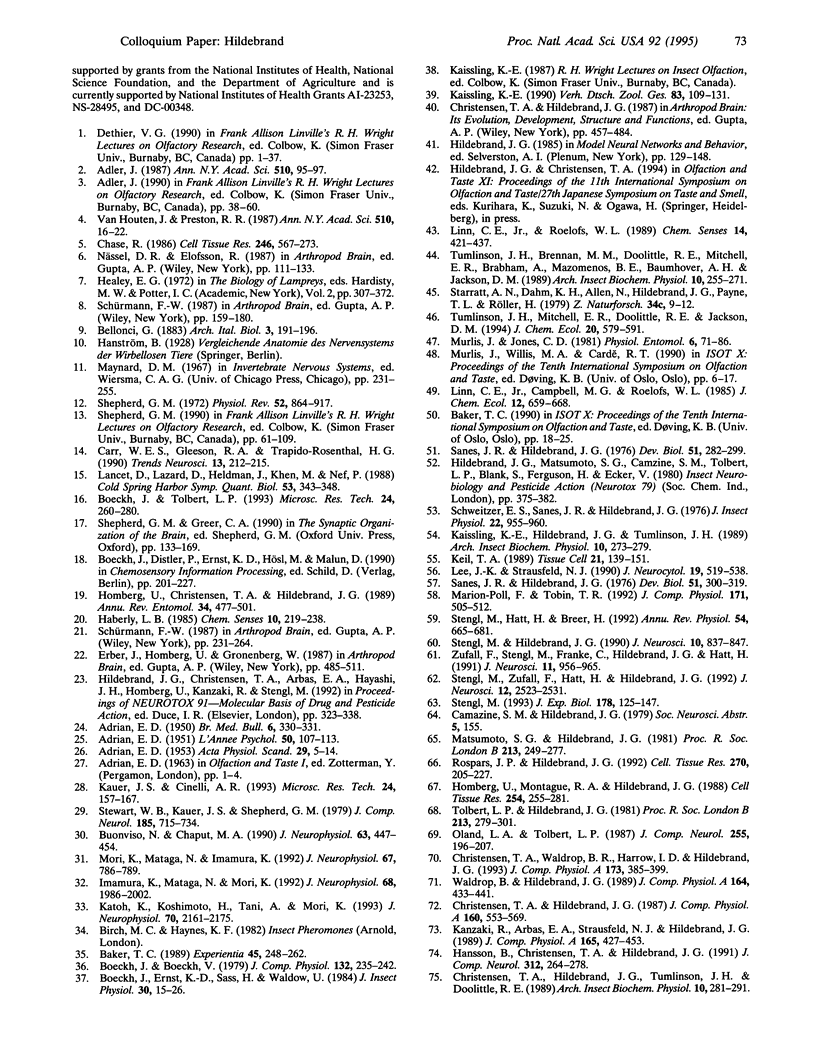
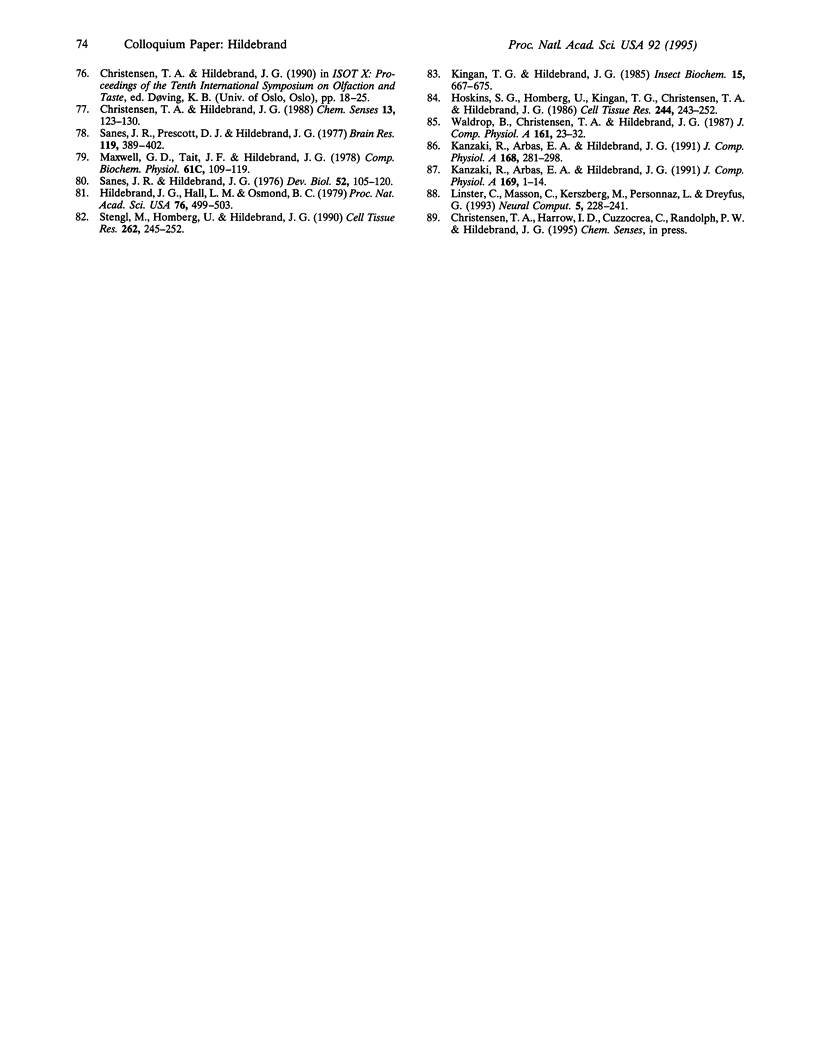
Selected References
These references are in PubMed. This may not be the complete list of references from this article.
- ADRIAN E. D. Sensory discrimination with some recent evidence from the olfactory organ. Br Med Bull. 1950;6(4):330–333. doi: 10.1093/oxfordjournals.bmb.a073625. [DOI] [PubMed] [Google Scholar]
- ADRIAN E. D. Sensory messages and sensation; the response of the olfactory organ to different smells. Acta Physiol Scand. 1953 Jun 26;29(1):5–14. doi: 10.1111/j.1748-1716.1953.tb00990.x. [DOI] [PubMed] [Google Scholar]
- Adler J. How motile bacteria sense and respond to chemicals. Ann N Y Acad Sci. 1987;510:95–97. doi: 10.1111/j.1749-6632.1987.tb43473.x. [DOI] [PubMed] [Google Scholar]
- Boeckh J., Tolbert L. P. Synaptic organization and development of the antennal lobe in insects. Microsc Res Tech. 1993 Feb 15;24(3):260–280. doi: 10.1002/jemt.1070240305. [DOI] [PubMed] [Google Scholar]
- Buonviso N., Chaput M. A. Response similarity to odors in olfactory bulb output cells presumed to be connected to the same glomerulus: electrophysiological study using simultaneous single-unit recordings. J Neurophysiol. 1990 Mar;63(3):447–454. doi: 10.1152/jn.1990.63.3.447. [DOI] [PubMed] [Google Scholar]
- Carr W. E., Gleeson R. A., Trapido-Rosenthal H. G. The role of perireceptor events in chemosensory processes. Trends Neurosci. 1990 Jun;13(6):212–215. doi: 10.1016/0166-2236(90)90162-4. [DOI] [PubMed] [Google Scholar]
- Christensen T. A., Hildebrand J. G. Male-specific, sex pheromone-selective projection neurons in the antennal lobes of the moth Manduca sexta. J Comp Physiol A. 1987 May;160(5):553–569. doi: 10.1007/BF00611929. [DOI] [PubMed] [Google Scholar]
- Christensen T. A., Waldrop B. R., Harrow I. D., Hildebrand J. G. Local interneurons and information processing in the olfactory glomeruli of the moth Manduca sexta. J Comp Physiol A. 1993 Oct;173(4):385–399. doi: 10.1007/BF00193512. [DOI] [PubMed] [Google Scholar]
- Hansson B. S., Christensen T. A., Hildebrand J. G. Functionally distinct subdivisions of the macroglomerular complex in the antennal lobe of the male sphinx moth Manduca sexta. J Comp Neurol. 1991 Oct 8;312(2):264–278. doi: 10.1002/cne.903120209. [DOI] [PubMed] [Google Scholar]
- Hildebrand J. G., Hall L. M., Osmond B. C. Distribution of binding sites for 125I-labeled alpha-bungarotoxin in normal and deafferented antennal lobes of Manduca sexta. Proc Natl Acad Sci U S A. 1979 Jan;76(1):499–503. doi: 10.1073/pnas.76.1.499. [DOI] [PMC free article] [PubMed] [Google Scholar]
- Homberg U., Christensen T. A., Hildebrand J. G. Structure and function of the deutocerebrum in insects. Annu Rev Entomol. 1989;34:477–501. doi: 10.1146/annurev.en.34.010189.002401. [DOI] [PubMed] [Google Scholar]
- Homberg U., Montague R. A., Hildebrand J. G. Anatomy of antenno-cerebral pathways in the brain of the sphinx moth Manduca sexta. Cell Tissue Res. 1988 Nov;254(2):255–281. doi: 10.1007/BF00225800. [DOI] [PubMed] [Google Scholar]
- Hoskins S. G., Homberg U., Kingan T. G., Christensen T. A., Hildebrand J. G. Immunocytochemistry of GABA in the antennal lobes of the sphinx moth Manduca sexta. Cell Tissue Res. 1986;244(2):243–252. doi: 10.1007/BF00219199. [DOI] [PubMed] [Google Scholar]
- Imamura K., Mataga N., Mori K. Coding of odor molecules by mitral/tufted cells in rabbit olfactory bulb. I. Aliphatic compounds. J Neurophysiol. 1992 Dec;68(6):1986–2002. doi: 10.1152/jn.1992.68.6.1986. [DOI] [PubMed] [Google Scholar]
- Kanzaki R., Arbas E. A., Hildebrand J. G. Physiology and morphology of descending neurons in pheromone-processing olfactory pathways in the male moth Manduca sexta. J Comp Physiol A. 1991 Jul;169(1):1–14. doi: 10.1007/BF00198168. [DOI] [PubMed] [Google Scholar]
- Kanzaki R., Arbas E. A., Hildebrand J. G. Physiology and morphology of protocerebral olfactory neurons in the male moth Manduca sexta. J Comp Physiol A. 1991 Mar;168(3):281–298. doi: 10.1007/BF00198348. [DOI] [PubMed] [Google Scholar]
- Kanzaki R., Arbas E. A., Strausfeld N. J., Hildebrand J. G. Physiology and morphology of projection neurons in the antennal lobe of the male moth Manduca sexta. J Comp Physiol A. 1989 Aug;165(4):427–453. doi: 10.1007/BF00611233. [DOI] [PubMed] [Google Scholar]
- Katoh K., Koshimoto H., Tani A., Mori K. Coding of odor molecules by mitral/tufted cells in rabbit olfactory bulb. II. Aromatic compounds. J Neurophysiol. 1993 Nov;70(5):2161–2175. doi: 10.1152/jn.1993.70.5.2161. [DOI] [PubMed] [Google Scholar]
- Kauer J. S., Cinelli A. R. Are there structural and functional modules in the vertebrate olfactory bulb? Microsc Res Tech. 1993 Feb 1;24(2):157–167. doi: 10.1002/jemt.1070240207. [DOI] [PubMed] [Google Scholar]
- Lancet D., Lazard D., Heldman J., Khen M., Nef P. Molecular transduction in smell and taste. Cold Spring Harb Symp Quant Biol. 1988;53(Pt 1):343–348. doi: 10.1101/sqb.1988.053.01.041. [DOI] [PubMed] [Google Scholar]
- Lee J. K., Strausfeld N. J. Structure, distribution and number of surface sensilla and their receptor cells on the olfactory appendage of the male moth Manduca sexta. J Neurocytol. 1990 Aug;19(4):519–538. doi: 10.1007/BF01257241. [DOI] [PubMed] [Google Scholar]
- Marion-Poll F., Tobin T. R. Temporal coding of pheromone pulses and trains in Manduca sexta. J Comp Physiol A. 1992 Nov;171(4):505–512. doi: 10.1007/BF00194583. [DOI] [PubMed] [Google Scholar]
- Maxwell G. D., Tait J. F., Hildebrand J. G. Regional synthesis of neurotransmitter candidates in the CNS of the moth Manduca sexta. Comp Biochem Physiol C. 1978;61C(1):109–119. doi: 10.1016/0306-4492(78)90120-x. [DOI] [PubMed] [Google Scholar]
- Mori K., Mataga N., Imamura K. Differential specificities of single mitral cells in rabbit olfactory bulb for a homologous series of fatty acid odor molecules. J Neurophysiol. 1992 Mar;67(3):786–789. doi: 10.1152/jn.1992.67.3.786. [DOI] [PubMed] [Google Scholar]
- Oland L. A., Tolbert L. P. Glial patterns during early development of antennal lobes of Manduca sexta: a comparison between normal lobes and lobes deprived of antennal axons. J Comp Neurol. 1987 Jan 8;255(2):196–207. doi: 10.1002/cne.902550204. [DOI] [PubMed] [Google Scholar]
- Rospars J. P., Hildebrand J. G. Anatomical identification of glomeruli in the antennal lobes of the male sphinx moth Manduca sexta. Cell Tissue Res. 1992 Nov;270(2):205–227. doi: 10.1007/BF00328007. [DOI] [PubMed] [Google Scholar]
- Sanes J. R., Hildebrand J. G. Acetylcholine and its metabolic enzymes in developing antennae of the moth, Manduca sexta. Dev Biol. 1976 Aug;52(1):105–120. doi: 10.1016/0012-1606(76)90011-7. [DOI] [PubMed] [Google Scholar]
- Sanes J. R., Hildebrand J. G. Origin and morphogenesis of sensory neurons in an insect antenna. Dev Biol. 1976 Jul 15;51(2):300–319. doi: 10.1016/0012-1606(76)90145-7. [DOI] [PubMed] [Google Scholar]
- Sanes J. R., Hildebrand J. G. Structure and development of antennae in a moth, Manduca sexta. Dev Biol. 1976 Jul 15;51(2):280–299. [PubMed] [Google Scholar]
- Sanes J. R., Prescott D. J., Hildebrand J. G. Cholinergic neurochemical development of normal and deafferented antennal lobes during metamorphosis of the moth, Manduca sexta. Brain Res. 1977 Jan 7;119(2):389–402. doi: 10.1016/0006-8993(77)90318-3. [DOI] [PubMed] [Google Scholar]
- Schweitzer E. S., Sanes J. R., Hildebrand J. G. Ontogeny of electroantennogram responses in the moth, Manduca sexta. J Insect Physiol. 1976;22(7):955–960. doi: 10.1016/0022-1910(76)90078-0. [DOI] [PubMed] [Google Scholar]
- Shepherd G. M. Synaptic organization of the mammalian olfactory bulb. Physiol Rev. 1972 Oct;52(4):864–917. doi: 10.1152/physrev.1972.52.4.864. [DOI] [PubMed] [Google Scholar]
- Stengl M., Hatt H., Breer H. Peripheral processes in insect olfaction. Annu Rev Physiol. 1992;54:665–681. doi: 10.1146/annurev.ph.54.030192.003313. [DOI] [PubMed] [Google Scholar]
- Stengl M., Hildebrand J. G. Insect olfactory neurons in vitro: morphological and immunocytochemical characterization of male-specific antennal receptor cells from developing antennae of male Manduca sexta. J Neurosci. 1990 Mar;10(3):837–847. doi: 10.1523/JNEUROSCI.10-03-00837.1990. [DOI] [PMC free article] [PubMed] [Google Scholar]
- Stengl M., Homberg U., Hildebrand J. G. Acetylcholinesterase activity in antennal receptor neurons of the sphinx moth Manduca sexta. Cell Tissue Res. 1990 Nov;262(2):245–252. doi: 10.1007/BF00309879. [DOI] [PubMed] [Google Scholar]
- Stengl M. Intracellular-messenger-mediated cation channels in cultured olfactory receptor neurons. J Exp Biol. 1993 May;178:125–147. doi: 10.1242/jeb.178.1.125. [DOI] [PubMed] [Google Scholar]
- Stengl M., Zufall F., Hatt H., Hildebrand J. G. Olfactory receptor neurons from antennae of developing male Manduca sexta respond to components of the species-specific sex pheromone in vitro. J Neurosci. 1992 Jul;12(7):2523–2531. doi: 10.1523/JNEUROSCI.12-07-02523.1992. [DOI] [PMC free article] [PubMed] [Google Scholar]
- Stewart W. B., Kauer J. S., Shepherd G. M. Functional organization of rat olfactory bulb analysed by the 2-deoxyglucose method. J Comp Neurol. 1979 Jun 15;185(4):715–734. doi: 10.1002/cne.901850407. [DOI] [PubMed] [Google Scholar]
- Van Houten J., Preston R. R. Eukaryotic unicells: how useful in studying chemoreception? Ann N Y Acad Sci. 1987;510:16–22. doi: 10.1111/j.1749-6632.1987.tb43460.x. [DOI] [PubMed] [Google Scholar]
- Waldrop B., Christensen T. A., Hildebrand J. G. GABA-mediated synaptic inhibition of projection neurons in the antennal lobes of the sphinx moth, Manduca sexta. J Comp Physiol A. 1987 Jun;161(1):23–32. doi: 10.1007/BF00609452. [DOI] [PubMed] [Google Scholar]
- Waldrop B., Hildebrand J. G. Physiology and pharmacology of acetylcholinergic responses of interneurons in the antennal lobes of the moth Manduca sexta. J Comp Physiol A. 1989 Jan;164(4):433–441. doi: 10.1007/BF00610437. [DOI] [PubMed] [Google Scholar]
- Zufall F., Stengl M., Franke C., Hildebrand J. G., Hatt H. Ionic currents of cultured olfactory receptor neurons from antennae of male Manduca sexta. J Neurosci. 1991 Apr;11(4):956–965. doi: 10.1523/JNEUROSCI.11-04-00956.1991. [DOI] [PMC free article] [PubMed] [Google Scholar]


